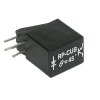I've got a super-simple application where I need to turn on an LED when a small project box is in a vertical position and have it turn off in a horizontal position.
Currently, I have the LED wired to a battery via a rolling ball vibration and tilt switch that I picked up at Mouser (https://www.mouser.com/Search/Produ...010-EVvirtualkey12040000virtualkey107-2010-EV)
It's all just hand wired together since it's so simple, but my problem is that the ball switch is too sensitive and breaks the connection with even the slightest vibration. I love it because it's so compact (about the size of an axial electrolytic cap), but other than that it's not doing what I want. I'm sure what I bought isn't the proper component to be using, but without trial and error I'm having a hard time finding the right one. In my mind I want a mercury switch in the same form factor, but I don't want to use mercury in this.
I also thought I could use the same tilt switch to trigger a timer or something that turned on the LED, but that adds build complexity that I was trying to avoid. If I have to do it, that's fine, but I'm hoping I can find a different component that does what I need.
So, anyone have any thoughts on a more appropriate tilt sensor?
Thanks,
Gabe
Currently, I have the LED wired to a battery via a rolling ball vibration and tilt switch that I picked up at Mouser (https://www.mouser.com/Search/Produ...010-EVvirtualkey12040000virtualkey107-2010-EV)
It's all just hand wired together since it's so simple, but my problem is that the ball switch is too sensitive and breaks the connection with even the slightest vibration. I love it because it's so compact (about the size of an axial electrolytic cap), but other than that it's not doing what I want. I'm sure what I bought isn't the proper component to be using, but without trial and error I'm having a hard time finding the right one. In my mind I want a mercury switch in the same form factor, but I don't want to use mercury in this.
I also thought I could use the same tilt switch to trigger a timer or something that turned on the LED, but that adds build complexity that I was trying to avoid. If I have to do it, that's fine, but I'm hoping I can find a different component that does what I need.
So, anyone have any thoughts on a more appropriate tilt sensor?
Thanks,
Gabe
Last edited:

